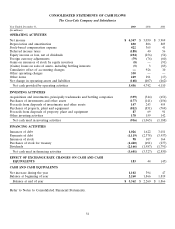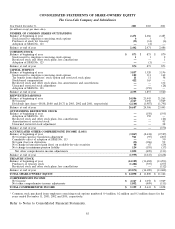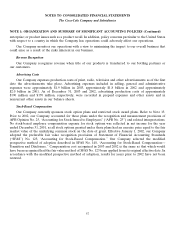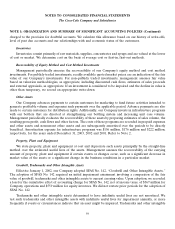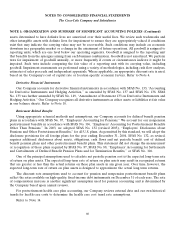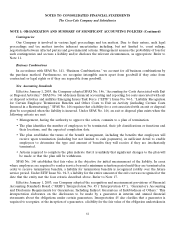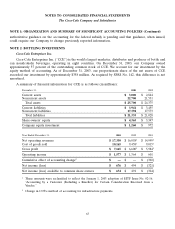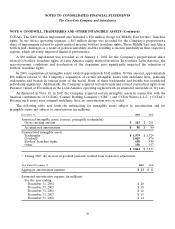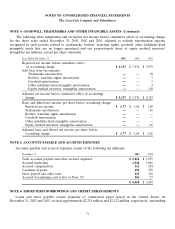Coca Cola 2003 Annual Report Download - page 64
Download and view the complete annual report
Please find page 64 of the 2003 Coca Cola annual report below. You can navigate through the pages in the report by either clicking on the pages listed below, or by using the keyword search tool below to find specific information within the annual report.NOTES TO CONSOLIDATED FINANCIAL STATEMENTS
The Coca-Cola Company and Subsidiaries
NOTE 1: ORGANIZATION AND SUMMARY OF SIGNIFICANT ACCOUNTING POLICIES (Continued)
Contingencies
Our Company is involved in various legal proceedings and tax matters. Due to their nature, such legal
proceedings and tax matters involve inherent uncertainties including, but not limited to, court rulings,
negotiations between affected parties and governmental actions. Management assesses the probability of loss for
such contingencies and accrues a liability and/or discloses the relevant circumstances, as appropriate. Refer to
Note 11.
Business Combinations
In accordance with SFAS No. 141, ‘‘Business Combinations,’’ we account for all business combinations by
the purchase method. Furthermore, we recognize intangible assets apart from goodwill if they arise from
contractual or legal rights or if they are separable from goodwill.
New Accounting Standards
Effective January 1, 2003, the Company adopted SFAS No. 146, ‘‘Accounting for Costs Associated with Exit
or Disposal Activities.’’ SFAS No. 146 addresses financial accounting and reporting for costs associated with exit
or disposal activities and nullifies Emerging Issues Task Force (‘‘EITF’’) Issue No. 94-3, ‘‘Liability Recognition
for Certain Employee Termination Benefits and Other Costs to Exit an Activity (including Certain Costs
Incurred in a Restructuring).’’ SFAS No. 146 requires that a liability for a cost associated with an exit or disposal
plan be recognized when the liability is incurred. Under SFAS No. 146, an exit or disposal plan exists when the
following criteria are met:
• Management, having the authority to approve the action, commits to a plan of termination.
• The plan identifies the number of employees to be terminated, their job classifications or functions and
their locations, and the expected completion date.
• The plan establishes the terms of the benefit arrangement, including the benefits that employees will
receive upon termination (including but not limited to cash payments), in sufficient detail to enable
employees to determine the type and amount of benefits they will receive if they are involuntarily
terminated.
• Actions required to complete the plan indicate that it is unlikely that significant changes to the plan will
be made or that the plan will be withdrawn.
SFAS No. 146 establishes that fair value is the objective for initial measurement of the liability. In cases
where employees are required to render service beyond a minimum retention period until they are terminated in
order to receive termination benefits, a liability for termination benefits is recognized ratably over the future
service period. Under EITF Issue No. 94-3, a liability for the entire amount of the exit cost was recognized at the
date that the entity met the four criteria described above. Refer to Note 17.
Effective January 1, 2003, our Company adopted the recognition and measurement provisions of Financial
Accounting Standards Board (‘‘FASB’’) Interpretation No. 45 (‘‘Interpretation 45’’), ‘‘Guarantor’s Accounting
and Disclosure Requirements for Guarantees, Including Indirect Guarantees of Indebtedness of Others.’’ This
interpretation elaborates on the disclosures to be made by a guarantor in interim and annual financial
statements about the obligations under certain guarantees. Interpretation 45 also clarifies that a guarantor is
required to recognize, at the inception of a guarantee, a liability for the fair value of the obligation undertaken in
61





